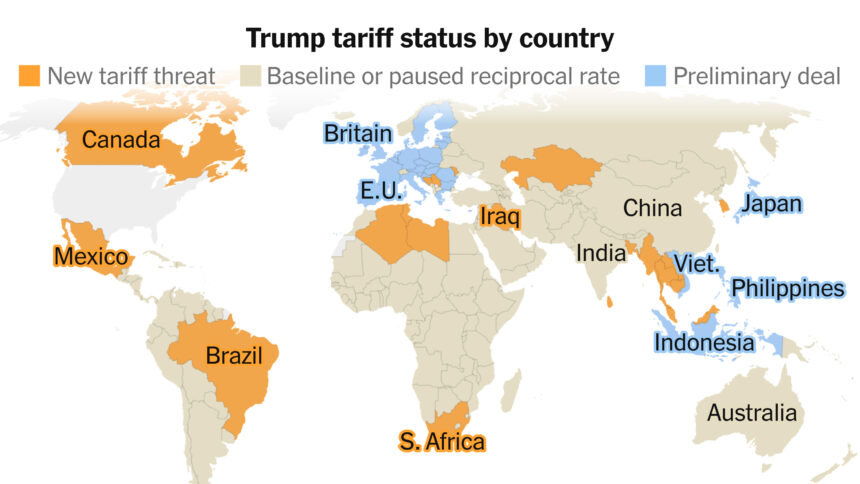Article – In the summer heat of Washington D.C., policy wonks and trade experts are sweating over more than just the humidity. President Trump’s latest round of tariffs targeting Canadian imports has sent shockwaves through North American supply chains that have been integrated for generations.
“We’re witnessing the most significant disruption to U.S.-Canada trade relations since the 1930s,” explains Marianne Cowell, senior trade analyst at the Peterson Institute for International Economics. “These aren’t just numbers on a spreadsheet—they’re relationships and livelihoods being fundamentally altered.”
The new tariffs—ranging from 25% on Canadian lumber to a staggering 45% on dairy products—represent a dramatic escalation in the administration’s “America First” trade policy. According to data from the U.S. Trade Representative’s office, Canada exported $319 billion in goods to the United States last year, making it America’s largest trading partner and the destination for nearly 75% of all Canadian exports.
Walking through the Port of Detroit last week, I witnessed the immediate effects firsthand. Trucks lined up for miles at border crossings, with new inspection procedures adding hours to transit times. Mike Desjardins, a Quebec-based driver who’s been crossing the border for 22 years, offered a grim assessment: “I used to make two round trips a week. Now I’m lucky if I complete one.”
The economic consequences are already materializing. A joint analysis from the Bank of Canada and Royal Bank of Canada suggests these tariffs could reduce Canadian GDP by 1.8% over the next year, while U.S. consumer prices for affected goods could rise between 4.5% and 9.7%. Construction materials have been particularly hard hit, with lumber prices jumping 17% in just three weeks.
Behind these statistics are real communities caught in the crossfire. In Sault Ste. Marie, a city straddling the border between Ontario and Michigan, the integrated steel industry that has sustained both sides for over a century now faces unprecedented uncertainty.
“My grandfather worked at Algoma Steel, my father worked there, and now I do too,” says Raymond White, a third-generation steelworker. “For the first time, I’m telling my kids to look for different careers. The instability is too much.”
The White House has justified these measures by citing national security concerns under Section 232 of the Trade Expansion Act, the same rationale used for previous steel and aluminum tariffs. When pressed for specifics, Commerce Secretary Wilbur Ross pointed to a trade deficit in certain sectors, despite the overall U.S.-Canada trade relationship being nearly balanced according to the Commerce Department’s own data.
Canadian Prime Minister Justin Trudeau has responded with targeted countermeasures, imposing duties on $14 billion of American goods. “We will not be pushed around,” Trudeau declared at an emergency cabinet meeting in Ottawa. The Canadian government has also filed challenges through both NAFTA dispute mechanisms and the World Trade Organization.
What makes these particular tariffs especially disruptive is their impact on complex supply chains. Modern manufacturing often involves components crossing borders multiple times before a final product is completed. The automotive industry, centered around the Great Lakes region, exemplifies this integration.
“A typical vehicle manufactured in North America crosses borders up to seven times during production,” explains Carlos Gutierrez, former U.S. Commerce Secretary and now a consultant for multinational corporations. “When you add tariffs to each crossing, the cumulative effect becomes untenable.”
Economists across the political spectrum have expressed concern. A survey of 42 leading economists by the University of Chicago found that 95% believe these tariffs will harm American consumers, with only one expressing uncertainty and none supporting the policy.
In border communities, the human dimension transcends economics. Windsor, Ontario and Detroit, Michigan function almost as a single economic zone, with thousands crossing daily for work, family visits, and commerce. New barriers threaten this organic relationship.
Windsor Mayor Drew Dilkens described the situation as “tearing at the fabric of our community.” His city has established an emergency fund to assist workers affected by slowdowns at automotive plants, which have already announced temporary layoffs as they adjust to the new trade reality.
American businesses dependent on Canadian inputs are scrambling to adapt. Malcolm Rodriguez, CEO of Minnesota-based Northern Building Products, told me his company is facing a triple threat: “Higher material costs, delayed deliveries, and uncertainty about future pricing make it impossible to bid on projects confidently.”
Rodriguez’s company has suspended plans for a facility expansion that would have added 47 jobs, joining a growing list of investments put on hold amid trade uncertainty.
The diplomatic fallout has been equally severe. Canadian Foreign Minister Chrystia Freeland canceled a planned Washington visit, while several state-province cooperation forums have been indefinitely postponed. A senior Canadian diplomatic source, speaking on condition of anonymity, characterized the relationship as “at its lowest point in modern history.”
Advocates of the tariffs, including Trade Representative Robert Lighthizer, argue short-term pain will yield long-term gains through renegotiated trade terms. However, economists like Nobel laureate Paul Krugman counter that disrupting established trade relationships typically produces more lasting damage than benefits.
“Trade wars are fundamentally negative-sum games,” Krugman wrote in a recent analysis. “The destruction of efficiency is real and permanent, while any negotiating leverage is temporary and often illusory.”
As fall approaches, both countries face crucial decisions. Canada’s retaliatory measures take full effect next month, while the U.S. administration must decide whether to exempt certain industries facing severe disruption. Meanwhile, everyday citizens on both sides of the world’s longest undefended border find themselves unwitting participants in a high-stakes economic experiment with no clear endgame.






